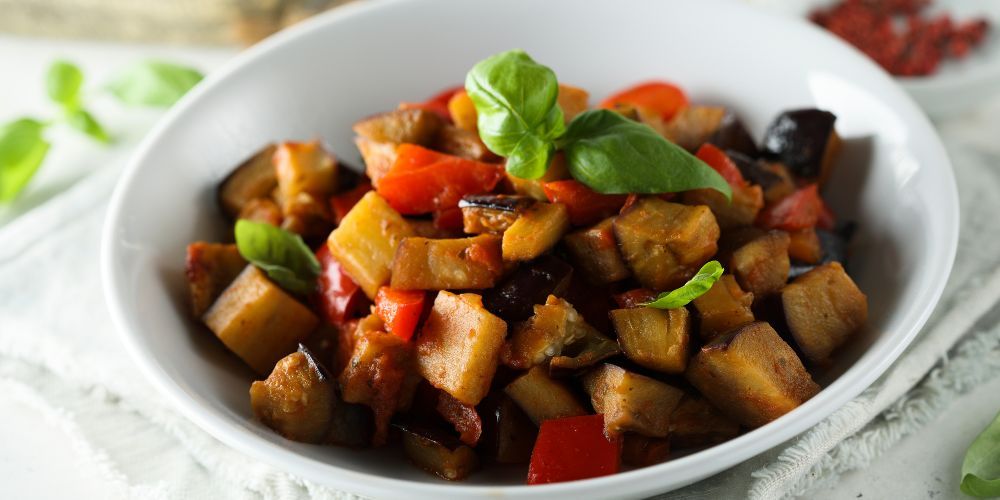Caponata is a traditional Italian dish, more precisely from the region of Sicily. Rich in history, it was born as a poor dish but now enriches all Italian tables, especially those of Southern Italy. There are many variations of this dish, think that in its island of origin, there are as many as forty: some add dried fruit, peppers, and even cocoa.
The main ingredient is eggplant and for this reason, it is the summer side dish par excellence; then follow the tomato and basil that should never be missing in any version, from the classic caponata to those with more particular flavors.

Origins and variations of caponata

Caponata is that dish that tells the whole culinary tradition of Sicily, one of the Italian regions renowned for their cuisine. This is a very special recipe because it has always been handed down from town to town, from generation to generation; that is why in Sicily alone there are so many variants of this dish that there are exactly 35.
There are 4 main variants found in Sicily:
- Palermitana, the classic version with eggplant, strictly Sicilian olives, onion, celery, capers, tomato sauce, vinegar and sugar;
- Trapanese, the one with the addition of dried fruits such as pine nuts and almonds;
- Agrigentina, with the addition of friggitelli, the dwarf green peppers;
- Ciancianese, the variant with more character enriched with artichokes and, in neighboring countries, they also add fruit such as peaches and pears.
Another variant is caponatina, originated in the Catania area, in which the pivotal ingredient, that is, sweet and sour sauce, is eliminated and new ones are introduced, namely potato and caciocavallo ragusano cheese.
With this variation we change region and move to Campania with a dish composed of freselle, tomato, basil and oregano sometimes with the addition of anchovies and anchovies.
Now let's talk about its history. Even today, the origins of this dish and the roots of its name are not well known. Some associate the name with "capone," a dialect term for lampuga, a fish that abounded on the tables of the elite of the time served with sweet and sour sauce, the very sauce that characterizes our caponata. The peasants, since they did not have as much money, replaced the lampuga with eggplant to recreate the delicious dish, thus creating a vegetarian dish accessible to all. Others, however, associate the name caponata with the Greek word "capto," to cut, because all the ingredients in this recipe are cut into small pieces; while another hypothesis holds that its name derives from "caupona," or tavern, a place frequented by sailors who used to consume bread with capers, oil and anchovies.
The ingredients, all from the farmers' garden, changed according to the season and the area of the island; this is another reason why there are so many variations of it.
Caponata recipe

Ingredients for 4 people:
- 500g eggplant
- 150g cherry tomatoes
- 100g onion
- 100g celery
- 50g tomato paste
- 1 tablespoon of salted capers
- 1 handful of green olives
- 2 tablespoons sugar
- 2 tablespoons white wine vinegar
- extra virgin olive oil
- oil for frying
- a few leaves of fresh basil
- salt
- pepper
First you need to wash and dice all the vegetables (celery, eggplant, cherry tomatoes). Start frying the eggplants and once ready set them aside. Then blanch the celery and set it aside as well. In a pan sauté the finely chopped onion with some olive oil, after 3 minutes add the tomato puree; after a few minutes dip the celery in it. While the ingredients are blending, add the green olives, capers and let them flavor; then add the tomato paste, sugar, vinegar and a little water to create the famous sweet and sour sauce. As a last step add the eggplant to this wonderful sauce, let all the ingredients mix for a few minutes adding salt, pepper and with the flame off a few leaves of fresh basil. Let it rest so that the vinegar is less obtrusive and finally serve it to your diners!
A word of advice: caponata is a dish that should be served cold; in fact, resting allows the vinegar to evaporate as long as possible so as not to overpower the rich flavor of the dish and achieve the unique flavor that caponata possesses. Of course, it can also be enjoyed hot, but the sweet and sour taste will overpower that of the vegetables.
For a light version, try stewing all the vegetables together and finally adding vinegar and sugar!
About the author
Written on 05/12/2023



Genny Lacava
How better to celebrate Italian cuisine than with this wonderful dish? Discover with us at Visit Italy all the secrets of caponata!